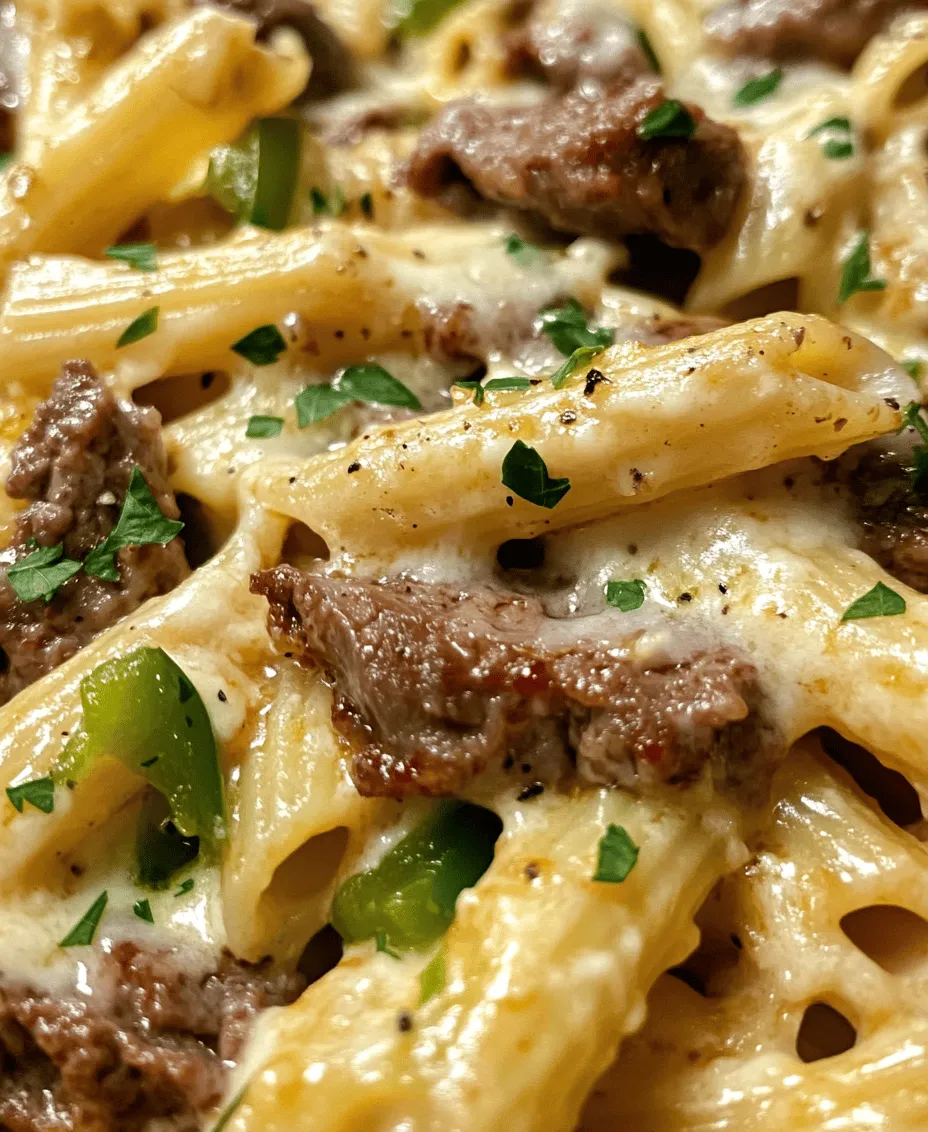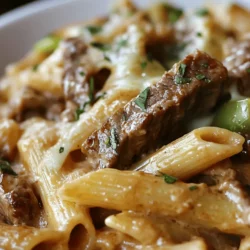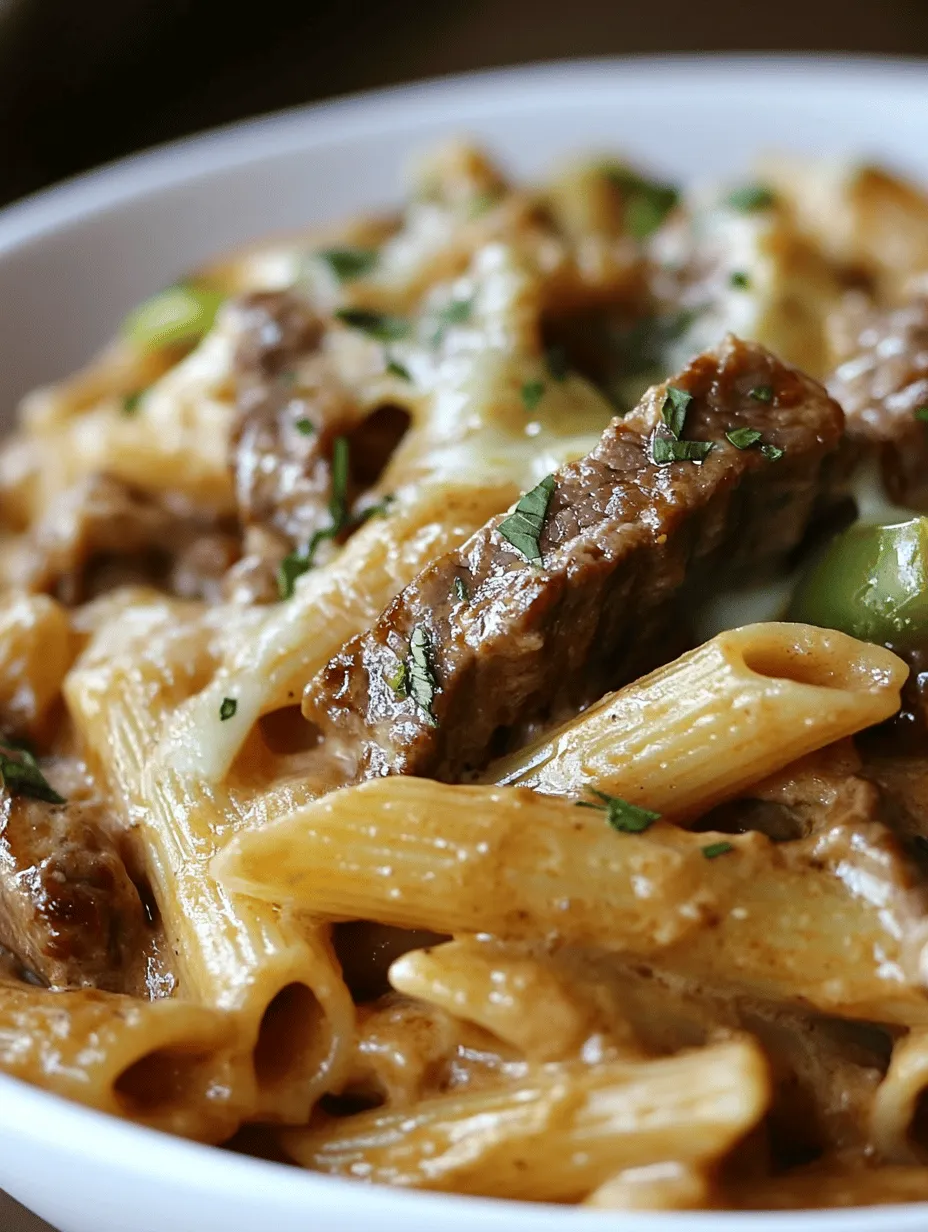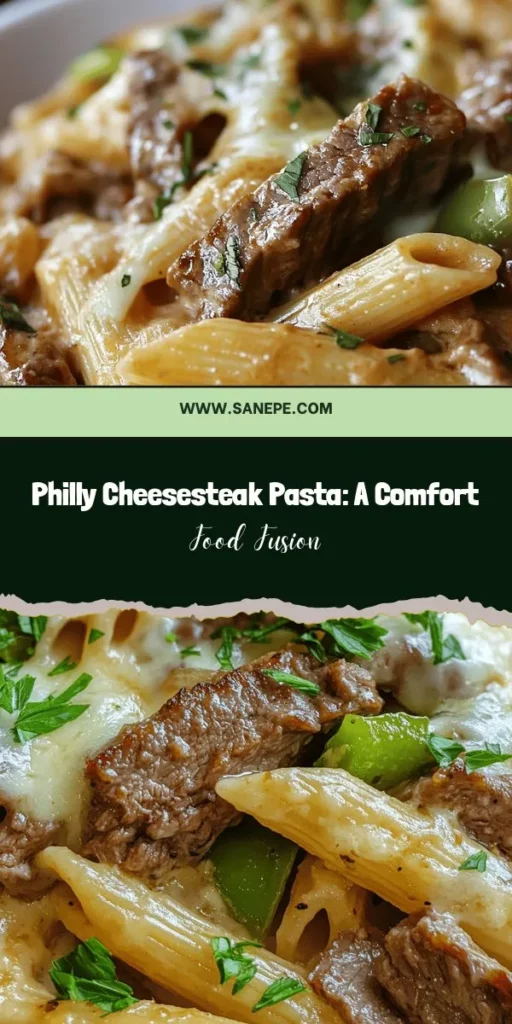Introduction
Welcome to a culinary journey where the beloved flavors of a classic Philly cheesesteak meet the comforting embrace of pasta. Introducing Philly Cheesesteak Pasta Delight, a dish that seamlessly fuses these two iconic meals into a single, mouthwatering experience. This innovative recipe brings together savory beef, sautéed vegetables, and a luxuriously creamy sauce, making it an ideal choice for busy weeknights or festive family gatherings.
Imagine a dinner that captures the essence of a Philly cheesesteak—rich, hearty, and undeniably satisfying—while being quick and easy to prepare. This dish not only satisfies your cravings but also provides a wonderful way to enjoy the beloved flavors of Philadelphia in a new and exciting form. The creamy sauce, combined with tender pasta and seasoned beef, ensures that every bite is packed with flavor, making this dish a crowd-pleaser for both kids and adults alike. Whether you are looking for a comforting meal after a long day or a dish that impresses your dinner guests, Philly Cheesesteak Pasta Delight is a perfect choice.
Understanding the Ingredients
To create a dish as delightful as Philly Cheesesteak Pasta, it’s essential to understand the key ingredients that bring this fusion recipe to life. Each component plays a vital role in achieving the dish’s signature taste and texture.
Exploring the Pasta Choice
When selecting pasta for this recipe, penne is the ideal choice. The tubular shape of penne not only adds an appealing aesthetic but also allows for optimal sauce retention. Its ridges and hollow center capture the rich, creamy sauce, ensuring that every forkful delivers a burst of flavor. Moreover, penne’s slightly firm texture holds up well against the heartiness of the beef and vegetables, making it a perfect partner in this comforting dish. Other pasta shapes like fusilli or rigatoni could work, but penne’s unique structure makes it stand out.
The Beef Selection
Choosing the right cut of beef is crucial for achieving the ideal flavor and texture in your Philly Cheesesteak Pasta. The recommended cuts for this recipe are ribeye and sirloin.
– Ribeye: Known for its rich marbling and tenderness, ribeye offers a robust flavor that elevates the dish. The fat content in ribeye not only enhances the taste but also keeps the beef juicy throughout the cooking process.
– Sirloin: A leaner alternative, sirloin is also a great option. It has a slightly firmer texture compared to ribeye but still provides a satisfying chew. Sirloin’s flavor is milder, allowing the seasonings and sauce to shine through without overwhelming the palate.
By using a combination of these two cuts, you can achieve a delicious balance of richness and tenderness, making each bite a savory delight.
Essential Vegetables
No Philly cheesesteak would be complete without the classic addition of onions and bell peppers. These vegetables not only enhance the flavor profile of the dish but also contribute to its overall texture.
– Onions: Adding sweetness and depth, onions are a staple in both cheesesteaks and this pasta dish. When sautéed, they caramelize beautifully, imparting a rich flavor that complements the savory beef.
– Bell Peppers: With their crisp texture and vibrant colors, bell peppers add a fresh element to the dish. Their slightly sweet and tangy flavor contrasts nicely with the richness of the beef and creamy sauce. Opt for a mix of red, yellow, and green bell peppers for a visually appealing and flavor-packed dish.
The Creamy Sauce
The sauce is the heart of this dish, and it’s what truly sets Philly Cheesesteak Pasta apart. A combination of cream cheese and beef broth creates a rich, satisfying sauce that envelops the pasta beautifully.
– Cream Cheese: This essential ingredient adds a creamy texture and tangy flavor, which helps to create a luscious sauce that clings to the pasta and beef.
– Beef Broth: Enhancing the savory notes of the dish, beef broth adds depth and richness to the sauce. It serves as the perfect base for the creamy goodness of the cream cheese, bringing all the flavors together.
To elevate the sauce even further, provolone and Parmesan cheese are essential additions. Provolone, known for its mild and slightly sharp flavor, melts perfectly into the sauce, creating a creamy and cheesy delight. Meanwhile, grated Parmesan adds a salty, nutty depth that enhances the overall flavor profile of the dish.
Preparation Steps
Now that we’ve explored the key ingredients that make up the Philly Cheesesteak Pasta Delight, let’s break down the preparation process into clear, detailed steps to guide you through creating this delicious dish.
Cooking the Pasta
Start by cooking the penne pasta to perfection. Here are some tips to achieve al dente pasta:
1. Boil Water: Fill a large pot with water and bring it to a rolling boil. Use about 4 to 6 quarts of water for every pound of pasta. Adding salt to the water enhances the flavor of the pasta as it cooks.
2. Add the Pasta: Once the water is boiling, add the penne pasta. Stir it immediately to prevent the noodles from sticking together.
3. Cook According to Package Instructions: Refer to the package for cooking times, usually around 11-13 minutes for al dente. Make sure to taste the pasta a minute or two before the recommended time to ensure it’s cooked to your liking.
4. Drain and Rinse: Once cooked, drain the pasta in a colander. Rinsing it lightly under cold water can stop the cooking process, but for this dish, you want to retain some starch, so a quick rinse is sufficient. Set the pasta aside, making sure it doesn’t stick together.
Sautéing the Vegetables
Next, it’s time to sauté the onions and bell peppers. This step is crucial as it enhances their flavors and brings out their natural sweetness.
1. Heat the Pan: In a large skillet, heat a tablespoon of olive oil over medium heat. You want the oil to shimmer but not smoke.
2. Add the Onions: Start by adding the sliced onions to the skillet. Sauté them for about 5 minutes until they become translucent. Stir frequently to avoid burning.
3. Incorporate the Bell Peppers: Once the onions are softened, add the sliced bell peppers to the skillet. Continue to sauté for an additional 5-7 minutes until the peppers are tender and slightly caramelized. The combination of sautéed onions and bell peppers will create a flavorful base for the beef.
Cooking the Beef
Finally, it’s time to cook the beef, which is the star of this dish. Here’s how to do it effectively:
1. Prepare the Beef: If you haven’t done so already, slice your ribeye and/or sirloin into thin strips, against the grain. This ensures that the beef remains tender.
2. Season the Beef: Sprinkle salt, pepper, and any other desired seasonings over the beef strips. This will enhance the flavors as you cook.
3. Sear the Beef: In the same skillet with the sautéed vegetables, push the veggies to the side and add the beef. Allow it to sear for about 2-3 minutes without stirring, letting it develop a nice crust.
4. Finish Cooking: Stir the beef and vegetables together and continue cooking for another 3-4 minutes until the beef is browned and cooked through. Remove from heat once fully cooked.
With the pasta cooked, vegetables sautéed, and beef perfectly seared, you’re now ready to combine these elements and create your Philly Cheesesteak Pasta Delight. Stay tuned for the next part, where we will delve into the assembly of this mouthwatering dish and the creation of the creamy sauce that makes it truly irresistible.

Cooking the Beef Quickly for Tenderness
When preparing the Beef for your Philly Cheesesteak Pasta Delight, the speed of cooking is crucial. Cooking the beef swiftly over high heat helps to lock in its natural juices, ensuring a tender and succulent result. Begin by slicing your steak against the grain into thin strips; this technique breaks up the muscle fibers, making the final dish much more enjoyable.
Before cooking, season the beef generously with salt and pepper. For added depth, consider a sprinkle of garlic powder or onion powder. These simple seasonings enhance the beef’s natural flavor without overwhelming the dish. Once seasoned, heat a large skillet over medium-high heat and add a splash of oil. When the oil is shimmering, add the beef in a single layer—avoid overcrowding the pan, as this can lead to steaming rather than searing. Cook the beef for about 2-3 minutes on each side, or until browned but not overcooked. After cooking, remove the beef from the skillet and set it aside. This ensures it remains tender and juicy while you prepare the sauce.
Creating the Cream Sauce
The cream sauce is the heart of this dish, providing richness and a smooth texture that envelops the pasta and beef. Begin with the base of your sauce by using the same skillet you cooked the beef in; this allows the flavors to meld beautifully.
Start by adding a block of cream cheese to the skillet over medium heat. Allow it to soften for a minute, stirring occasionally. Gradually pour in beef broth while stirring continuously. This method helps to break down the cream cheese, creating a creamy, well-integrated sauce. For an added layer of flavor, consider incorporating a splash of Worcestershire sauce or a teaspoon of Dijon mustard; both ingredients complement the beef beautifully.
As the sauce begins to thicken, taste it to ensure it’s seasoned well. You might want to add a pinch of smoked paprika or a dash of hot sauce for a subtle kick. Once the sauce is smooth and creamy, reduce the heat to low and stir in grated cheese—Provolone or a blend of cheeses work wonderfully. Stir until the cheese is melted and fully incorporated into the sauce, creating a luscious texture that will coat the pasta perfectly.
Combining Ingredients
With your pasta cooked al dente and your sauce ready, it’s time to bring the dish together. In a large mixing bowl, combine the cooked pasta with the creamy sauce, ensuring that each piece of pasta is well coated. This mixing is not just about combining ingredients; it’s about creating a harmonious marriage of flavors that will shine in every bite.
Next, add the seared beef to the pasta and sauce mixture. Gently fold everything together, being careful not to break up the pasta or beef too much. This step is essential as it ensures that the beef is evenly distributed throughout the dish, allowing each forkful to be packed with flavor. For an extra burst of flavor, consider adding sautéed bell peppers and onions at this stage, mimicking the traditional toppings of a Philly cheesesteak.
Serving Suggestions
Presentation can elevate your Philly Cheesesteak Pasta Delight from simple comfort food to an impressive meal. Start by serving the pasta in shallow bowls, allowing the vibrant colors to shine through. A sprinkle of freshly grated cheese on top just before serving adds a delightful touch, making the dish visually appealing.
For an added flair, consider drizzling a little extra cream sauce over the top or adding a few slices of sautéed bell peppers as a garnish. This not only enhances the visual aspect but also invites diners to enjoy the classic cheesesteak flavors that inspired the dish.
Garnishing Techniques
Garnishing your dish with fresh parsley can make a significant impact. Not only does it provide a burst of color, but it also adds a fresh, herbal note that balances the richness of the cream sauce. To garnish, chop fresh parsley finely and sprinkle it over the top just before serving. This small touch can make your dish look like it came straight from a gourmet kitchen.
Pairing Recommendations
To complement your Philly Cheesesteak Pasta Delight, consider serving a crisp green salad with a light vinaigrette. The acidity will cut through the richness of the pasta, creating a well-rounded meal. Alternatively, garlic bread or a side of roasted vegetables can also enhance the dining experience.
When it comes to beverages, a light-bodied red wine, such as Pinot Noir, pairs beautifully with the dish. If you prefer non-alcoholic options, consider sparkling water with a slice of lemon or a fruity iced tea to refresh the palate.
Nutritional Information
Understanding the nutritional breakdown of your Philly Cheesesteak Pasta Delight can help you enjoy it mindfully. A standard serving size is approximately 1.5 cups, which typically contains the following nutritional components:
– Calories: Approximately 600-700 calories per serving, depending on the specific ingredients used and portion sizes.
– Protein: Around 30-35 grams, primarily from the beef and cheese.
– Carbohydrates: Roughly 70-75 grams, largely from the pasta.
– Fats: About 25-30 grams, coming from cream cheese and cheese, with some healthy fats from cooking oil.
Caloric Breakdown
When considering how this dish fits into a balanced diet, the caloric breakdown is essential. If you’re watching your calorie intake, you can easily adjust the recipe for a lighter version by reducing the amount of cheese or opting for whole grain pasta. This allows you to enjoy the comforting flavors of your Philly Cheesesteak Pasta Delight while being mindful of your dietary goals.
Health Considerations
For those with dietary restrictions or who are health-conscious, there are several modifications you can make for your Philly Cheesesteak Pasta Delight. For a lighter version, consider using reduced-fat cream cheese and less cheese overall. Substituting whole grain pasta not only adds fiber but also enhances the nutritional profile of the dish. If you want to reduce the meat, feel free to increase the amount of vegetables like mushrooms or bell peppers, which can add both flavor and nutrition.
Conclusion
In conclusion, creating your Philly Cheesesteak Pasta Delight is an enriching culinary experience that transforms the classic flavors of a Philly cheesesteak into a comforting pasta dish. This recipe encapsulates the joy of cooking and indulging in hearty, flavorful food that brings the family together.
With its creamy sauce, tender beef, and perfectly cooked pasta, this dish is not only easy to prepare but also satisfying enough to impress your guests. The combination of textures and flavors makes it a perfect candidate for a weeknight dinner or a special occasion.
So gather your ingredients, follow the steps, and enjoy the delightful experience of sharing this comforting meal with family and friends. Embrace the simplicity of the recipe and relish the joy of indulging in a truly delicious comfort food masterpiece.


